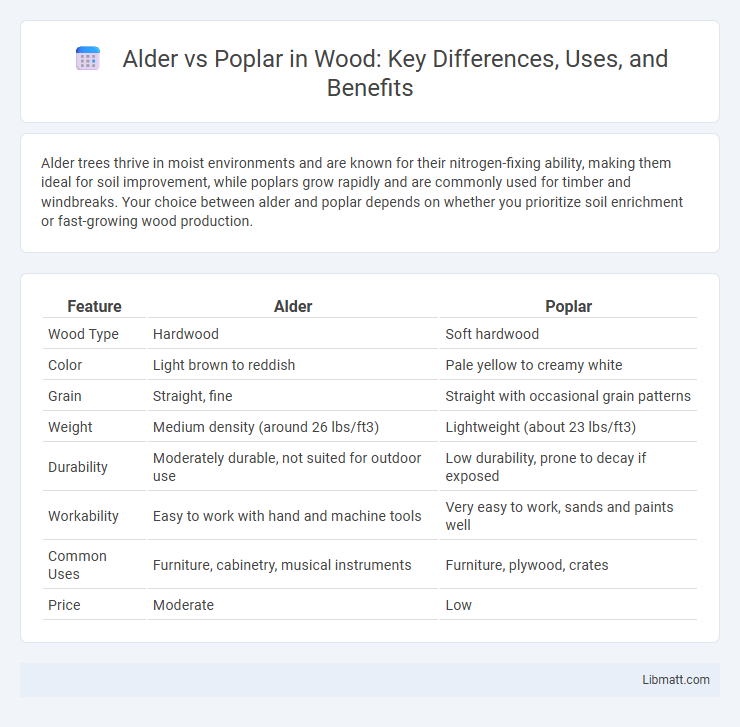Alder trees thrive in moist environments and are known for their nitrogen-fixing ability, making them ideal for soil improvement, while poplars grow rapidly and are commonly used for timber and windbreaks. Your choice between alder and poplar depends on whether you prioritize soil enrichment or fast-growing wood production.
Table of Comparison
| Feature | Alder | Poplar |
|---|---|---|
| Wood Type | Hardwood | Soft hardwood |
| Color | Light brown to reddish | Pale yellow to creamy white |
| Grain | Straight, fine | Straight with occasional grain patterns |
| Weight | Medium density (around 26 lbs/ft3) | Lightweight (about 23 lbs/ft3) |
| Durability | Moderately durable, not suited for outdoor use | Low durability, prone to decay if exposed |
| Workability | Easy to work with hand and machine tools | Very easy to work, sands and paints well |
| Common Uses | Furniture, cabinetry, musical instruments | Furniture, plywood, crates |
| Price | Moderate | Low |
Introduction: Alder vs Poplar
Alder trees, belonging to the genus Alnus, are known for their nitrogen-fixing ability and preference for moist, nutrient-rich soils, making them ideal for riparian zones. Poplar species, from the genus Populus, exhibit rapid growth and adaptability to various soil types, often used in timber production and bioenergy plantations. Both trees contribute to ecosystem restoration, but alder enhances soil fertility, while poplar excels in fast biomass accumulation.
Botanical Overview
Alder (Alnus spp.) and poplar (Populus spp.) are deciduous trees belonging to the Betulaceae and Salicaceae families, respectively, with distinct botanical characteristics. Alder trees typically have serrated, ovate leaves and catkin-shaped flowers appearing before leaf emergence, while poplars feature broader, triangular to lanceolate leaves and develop catkins that bloom simultaneously with leaves. Both genera are fast-growing, with alders often found in moist, nitrogen-rich soils due to their symbiotic relationship with nitrogen-fixing bacteria, whereas poplars thrive in diverse environments, exhibiting greater adaptability to dry and saline conditions.
Physical Characteristics
Alder trees typically have smooth, gray bark and rounded leaves with serrated edges, while poplar features rougher, deeply furrowed bark and larger, more triangular leaves. Alder wood is denser and has a reddish-brown hue, contrasting with poplar's lighter, softer, and pale yellowish wood. Your choice depends on preference for bark texture and wood density in landscaping or woodworking projects.
Workability and Machining
Alder wood is highly regarded for its excellent workability, featuring a fine, uniform texture that allows for smooth cutting, sanding, and shaping, making it ideal for cabinetry and furniture projects. Poplar, while also easy to machine, tends to have a softer grain that can sometimes result in a less clean edge, requiring careful handling to avoid splintering during cutting or routing. Both woods respond well to hand and power tools, but alder's consistent grain pattern generally provides superior machining precision and finishes.
Appearance and Grain Patterns
Alder wood features a smooth, consistent grain with a light brown to reddish hue, often displaying subtle patterns that enhance its natural warmth. Poplar typically presents a straighter, more uniform grain with a pale cream to greenish tone, sometimes showing streaks or patches that add character without overwhelming the surface. Your choice between alder and poplar will influence the aesthetic appeal of woodworking projects based on these distinct appearance and grain pattern differences.
Durability and Strength
Alder wood offers moderate durability and strength, making it suitable for indoor furniture and cabinetry where excessive wear is minimal. Poplar tends to be softer and less durable, often used for painted projects or lightweight applications where structural integrity is less critical. Your choice between alder and poplar should depend on the specific strength requirements and expected longevity of the finished product.
Common Uses in Woodworking
Alder wood is favored in woodworking for furniture, cabinetry, and interior trim due to its fine grain and ease of staining, providing a smooth finish that mimics more expensive hardwoods. Poplar is commonly used for painted furniture, molding, and crafts because of its affordability, light weight, and consistent texture that accepts paint and stains well. Both woods are soft hardwoods but alder is preferred when a richer finish is desired, while poplar excels in cost-effective projects requiring a uniform surface.
Cost and Availability
Alder wood typically costs more than poplar due to its durability and aesthetic appeal, but it remains readily available in most hardwood markets. Poplar is generally more affordable and widely accessible, making it a popular choice for budget-conscious projects. Your selection depends on balancing cost constraints with the desired availability and wood characteristics.
Environmental Impact
Alder trees contribute positively to soil health by fixing nitrogen, enriching the ecosystem and supporting biodiversity better than poplar species. Poplars grow rapidly and sequester significant amounts of carbon dioxide, making them valuable for carbon offset projects but they require more water, which can strain local water resources. Both species play vital roles in reforestation and habitat restoration, yet alders generally promote a more balanced and sustainable environmental impact through improved soil fertility and water management.
Which Wood Should You Choose?
Alder wood offers a smooth texture and rich reddish-brown color, making it ideal for furniture and cabinetry that require a warm, refined finish. Poplar wood, however, is lighter in weight and features a pale, uniform appearance, which suits projects where ease of painting and cost-effectiveness are priorities. When deciding which wood to choose, consider whether your priority is Alder's durability and aesthetic richness or Poplar's affordability and versatility for painted surfaces.
Alder vs poplar Infographic

 libmatt.com
libmatt.com